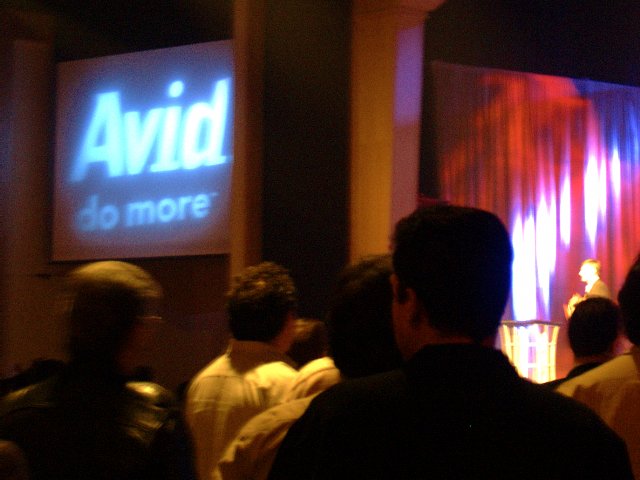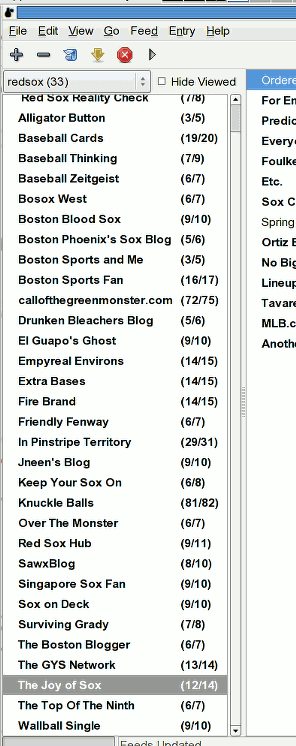Or more specifically, DS Assist 8.0 on a Macbook Pro running Windows. DNxHD plays back in real time with (software) realtime CC and titles.
And it could be yours for only 10K$!
I guess this is a Tiny House blog now
Or more specifically, DS Assist 8.0 on a Macbook Pro running Windows. DNxHD plays back in real time with (software) realtime CC and titles.
And it could be yours for only 10K$!
Avid:
da Vinci:
Facilistech:
Apple:
Autodesk:
Adobe:
Panasonic:

From the User Event:
Media Composer:
Feature improvements to composer:
Avid Interplay:
Storage:
DS Nitris 8:
XpressPro HD
Other:
I bought a cheap Samsung hard drive on newegg.com over the weekend, and it arrived today. I booted up the system, and…
*BEEP* *BEEP*
ERROR 2010: Warning: Your internal hard disk drive (HDD) may not function correctly on this system. Ensure that your HDD is supported on this system and that the latest HDD firmware is installed. Pressto continue
It turns out that, although Thinkpads use PATA hard drives, they are very picky about which ones. This is because the later T43 models use an SATA to PATA bridge chipset to convert between the Sonoma chipset and the much more affordable PATA drive standard.
What this means is that drives have to be specially coded to work with this bridge, and the Thinkpad has a little internal list that makes sure that the drive is known as compatible. If your drive isn’t on this list, the Thinkpad beeps at you on every boot.
I might be able to get my beautiful new drive to work, but right now I’m having trouble getting GRUB to figure out where it is. This is because GRUB needs the BIOS drive listing, and naturally the BIOS isn’t recognizing the drive. Linux sees it fine, though.
I got it to boot, but I still worry that something will go wrong. The two big warnings on the wiki are “slow” and “unreliable.” So far it is definitely not slow, but I’ll have to wait a few days for the “unreliable” part.
Update:
So it’s looking ok for now. I’m going to give it a couple weeks before I really trash the old one.
Filesystem Size Used Avail Use% Mounted on
/dev/sda1 108G 49G 55G 47% /
I’d rather have to put up with 160$, two beeps and pushing escape every boot for 120gigs; as opposed to 300$ for 100 IBM-sanctioned gigs.
Am I ready for opening day?

With 33 Red Sox blogs, you bet I am.
oooooh. This is a mac mini clone with linux-friendly hardware. If there was decent software to stream music over wireless, it would make a great kitchen PC. Or since it has ethernet and wifi, it’d be a great little home server. There’s always a need for little servers and firewalls, and this looks like a great choice for those uses.
Today I wasted a lot of time on a Computer Maintenance Issue. I haven’t had to do this in a while, so I thought I’d document the experience for posterity.
Continue reading “adventures in linux”
RE: Why The Web Is Hitting A Wall in BusinessWeek.
The 47-year-old Princeton University grad thinks the Net is largely a waste of time. Assistants print out e-mails for him and researchers give him paper copies of Wall Street analysts reports from the Web.
Gee, you don’t have to browse the internet at all, just as long as you have assistants and researchers to print out every page you need to read. What a simple solution to all this complicated clicking and googling business!
The article does go on to talk about other people who reasonably don’t use the internet either, but some of the reasons are pretty lame. Hatred of email seems to come up a lot. Protip: don’t start your email program — there’s more to the internet than email. Someone else is paranoid that Big Brother is going to steal her privacy. I think someone’s been watching too much local news.
Overcomplication is also a big complaint, which is totally understandable. But then one person says:
“We’ve had so much time to come up with a computer and Internet that are easier to use and work better, but we haven’t done it.”
Um, no we haven’t. The World Wide Web as most people know it only got popular 11 years ago. Graphical user interfaces are really only 20 years old, but computers weren’t even capable of rich color and smooth motion until the last couple years. Compare that with the television — close to 60 years old, or the car — over 100 — the two common comparisons for “easy-to-use” consumer items. Computers will eventually be easy to use, but we’re still in the “adjusting the vertical hold” and “cranking the front of the car” stage of development. I think people mistakenly correlate rapidity of technological development with usability development. One goes as fast as engineers can think up new ways to make things fast, but the other requires longterm study and user testing.
I think internet penetration will continue to slowly rise as old people die, as rural areas get network coverage, and as usability progresses. I don’t know if it’ll ever be near-100% like television, but it could approach that. Television is a one-way medium, and nothing is simpler than sitting on your ass. It’s hard to compete with that.
This is a point-by-point discussion of the LA Times article found here.
TURIN, Italy — As Olympic TV ratings sagged over the last two weeks and viewers switched channels from the Games to “American Idol,” NBC got one piece of very good news.The network’s website for the 2006 Turin Games, NBCOlympics.com, recorded 338 million page views through Saturday, more than doubling the number of hits from the 2002 Salt Lake City Games.
And that, some experts said, was promising not only for broadcasters but for the entire Olympic movement. “We are clearly in a new era,” said David Carter, executive director of the USC Sports Business Institute. “We have to see a new model for how the Olympics are delivered.”
The Internet could lead straight to a group that broadcasters and the International Olympic Committee covet most — young fans. Enmeshed in a world of text messaging, chat rooms and instant news, this demographic appears to be turned off by nightly packaged programming.
Actually, everyone was turned off by nightly packaged programming. This isn’t some reaction of the hip youth against old fogies, it’s the reaction of a country with a lot of channels to choose from against a ludicrous idea that people would watch 4 hours of olympics every night for two weeks.
For the last summer olympics I tried to record sports I wanted to see, but they were lost in gigantic 3 or 4 hour blocks that often didn’t even contain the sports they claimed would be shown. When I saw this year that it was the same thing, I didn’t even bother scheduling recordings.
With the time difference in Italy, that meant waiting around to watch events that had finished hours earlier.
“They’re saying, ‘What do you mean I can’t see it now?’ ” said Paul Swangard, managing director of the Warsaw Sports Marketing Center at the University of Oregon.
Not only are young consumers hungry for quick information, experts said, they are accustomed to paying for it.
I thought the internet was full of blood-sucking pirates who wouldn’t pay for anything?
Unlike their parents, who grew up watching over-the-air television and listening to the radio, the newer generation is comfortable with monthly cable bills and pay-per-view and spending money to download music.
In an odd way, putting more of the Games online with streaming video would hark back to the “Triplecast,” an old broadcasting experiment gone awry.
At the 1992 Barcelona Games, NBC offered a subscription package that gave viewers live and greatly expanded coverage. There weren’t many takers and the “Triplecast” flopped, considered something of a joke within the industry.
Yet, more than a decade later, the model might be updated.
“The notion of what it represented is not a bad idea in 2006,” Swangard said. “This idea that someone is willing to pay for the Olympics when they want it, how they want it.”
The tricky part will be figuring out how to package myriad events and how to charge for them.
NBC, I’ll save you millions of dollars and tell you the answer: Set up a TV schedule that lists exactly when events occur so that a Tivo or other recording device can record only the sports I want to watch. Then upload every single event as separate clips online, so I can watch everything.
Should viewers have to subscribe to the entire Games? Might they be able to order specific events or days? And how can the IOC protect itself against piracy in a wide-open medium?
Another free answer: a one-time fee for access to everything. It should cost 10$. After I pay my 10$ I can download and stream every single clip of every athlete in every event. Piracy will be a non-issue if you make it work on all three major platforms, provide decent resolution, and make it painless to search for whatever I want. Customizable, authenticated RSS feeds with enclosures would mean I could download just Jamaican Bobsledders, or only Sasha Cohen. This is all doable right now.
“It’s an incredible challenge and an incredible burden,” Carter said.
In light of television ratings the last two weeks, it might be a challenge worth facing.
“For generations, the media has supplied [the Olympics] on their own terms,” Carter said. “Now consumers are demanding how they want it, and it’s about time the industry woke up.”
The crazy thing about this discussion is that it’s only happening after the Olympics, after the poor ratings that everyone predicted. Everyone knew the Olympics were going to bomb, and they did. How bad are the ratings going to have to get until NBC decides to try something different? Or will we have to wait until someone else buys the Olympics rights before anything changes?